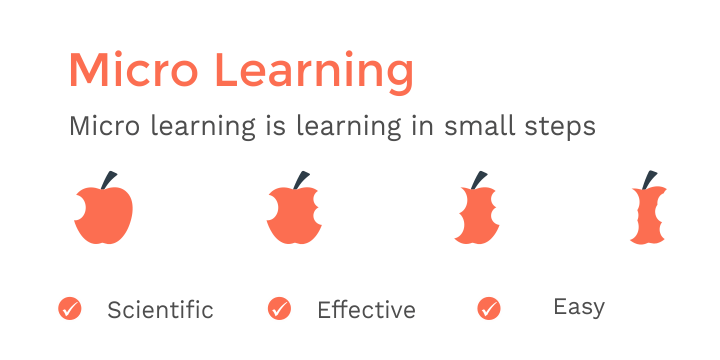Micro-Learning deals with smaller learning units and short-term learning activities in comparison to macro learning. The concept is mostly used in e-learning and related fields of in-service training processes in moderated environments. In this blog, we have attempted to make our readers understand how corporate workplaces can adopt Micro-learning. Have a look!
Table of Contents
Why Adopt Micro-Learning?

Content delivery through micro-learning bytes eases content distribution and consumption. It has been proven to be beneficial for the corporate workplace to adopt microlearning. Micro-learning is a teaching and learning method that focuses on delivering lessons in small bursts that are easy to absorb and can be retained and transferred into use right away. The knowledge that is offered through the modules to the consumer is sifted, selected, and reduced to the bare minimum. Its focus is on what must be known and most important and free of unnecessary information and clutter.
Micro-Learning is proving to be a useful tool for quick access to information. However, it’s not a replacement for in-depth courses that allow mastery over a topic. It’s best used for training purposes and is done without much focus on the reasons.
The Advantages of Micro-Learning for Corporates
1. Reduces Cost of Training
- Reduces development costs by 50%.
- In Micro-Learning there is no need or a very reduced need to buy or rent a classroom, pay for utilities, acquire the necessary equipment, or pay for the instructor’s hours.
- Expeditious growth and development are made possible with Micro Learning modules.
- Micro-Learning content can be designed and developed 300% faster than traditional eLearning courses, therefore, less time-consuming It’s easier to transact these micro modules, and the cost is reduced, as well.
2. Retention of Knowledge is Increased
- Knowledge transfer is 17% more efficient with micro-learning.
- Using spaced repetition Micro-Learning improves information retention Micro-Learning helps employees beat the forgetting curve by learning interventions in the form of small modules.
- It declutters the mind of the learner and helps in focusing on the key takeaways.
- Micro-Learning units should be interactive since we retain 90% of the information we see and hear.
3. Boosts Application of Knowledge
- Through Micro-Learning it is easier to engage learners in regular practice, or provide just-in-time learning than go for details and this helps in enhanced performance.
- Modules of Micro-Learning can be designed in a need-based manner for learners. Its delivery can be exactly at their time of need and can be furnished for performance support.
- It’s not a simple split of a long course into short segments, but each unit must be completely standalone and offer full information.
4. Enhances Learner Engagement
- In Micro-Learning it has been proven that employees get more engaged when the learning modules are provided to them in short bursts. Modules of a maximum duration of 7 to 11 minutes are most useful.
- Micro-Learning can be made more interesting using various formats of content delivery such as videos, infographics, animations, and simulations.
5. Contributes to Extensive Learning
Shorter learning bursts improve training completion rate.
Micro-Learning helps provide performance support that enables learners to make real-time decisions required in their jobs.
Disadvantages of Micro-Learning
Micro-Learning is not the be-all-end-all solution and can in no way replace all other forms of eLearning since it has many compromises and disadvantages.
● Micro-Learning, with its focus on small bursts of learning, can not build a knowledge base for the learners since it depends heavily on information
● Macro learning includes the concepts of deep learning whereas Micro-Learning touches upon the main points of a topic.
● Micro-Learning can not handle a large body of material that needs to be studied and comprehended in detail. Broad knowledge and good insights into the bigger picture or an understanding are not possible in Micro-Learning.
● Micro knowledge offers a limited understanding of standalone facts, however correct they might be, they cannot add substantially to the knowledge base.
Forecasts for Micro-Learning
Micro-Learning platforms will be best suited for mobile learning, and mobile use is poised to dominate desktop internet use and is more futuristic. We have seen the changes the Covid-19 pandemic brought to the world and soon we will depend more heavily on Micro-Learning through mobile apps. In this new landscape, microlearning will be an irreversible feature in eLearning.
– Microlearning statistics say 100% of employees will take the training if there is a game involved. By keeping the bursts short and with multimedia and gamification in it, Microlearning is going to be the next most popular eLearning option.
– Learners remember stuff they’ve been taught through microlearning better. Short and crisp.
– Learners can do it anywhere and it doesn’t demand too much of your time. So it will become more popular in the times to come.
Bottomline
Micro-Learning is a great learning methodology and an excellent addition to macro learning courses. In the future, when micro and macro are combined together, it will certainly open up a lot of ways to eLearning. For more such intriguing content, head to SaaSworthy.com!
Read More
Consumer Behavior Statistics in 2022
An Extensive Guide to Objectives and Key Results Software in 2022






